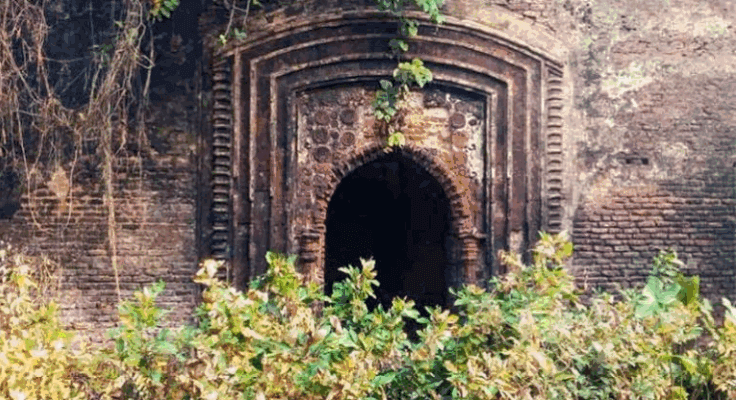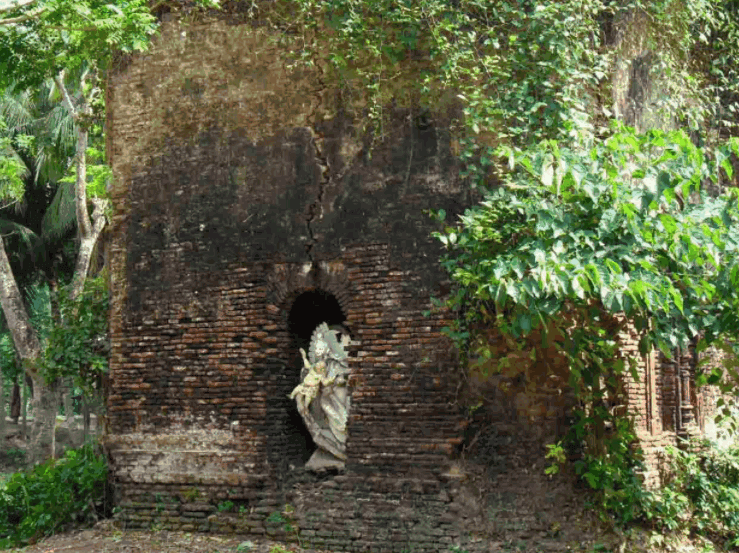
A dilapidated pile of bricks, walls surrounded by moss and weeds, the existence of a century-old building seems to be shattered at the click of a button. The protruding red brick walls and terracotta seem to tell the story of a bygone era. Once upon a time, there was the silence of the crematorium in the area where the cassava used to resound with drums, instruments, and instruments.
There are no priests to offer evening prayers, no footsteps of priests, and no tingling of bells. Where the melody of the conch would have floated far and wide in the evening, there is the silence that makes me upset today. Dochala is a place of worship with its head held high, holding the memory of the time in its chest.
It is clear from the beginning that I was talking about an ancient temple. The temple is located at Nolia village in Jamalpur union of Baliakandi Upazila of Rajbari district in Padmapar district. The temple here is not one, but two. According to the locals, the place where the present temple is located used to be Padma Char and the place was full of reed forest, which is why the name of this place became Naliya in the mouths of people.
It was here that Raja Sitaram Roy established this temple and erected an idol in about 1755 AD. Since no Brahmin priest was found in the village at that time, at the request of the king, Sri Krishna Ram Chakraborty came to the village from the neighboring village and took charge of the maintenance of the Dev Mandir and Vigraha.

The construction of the temple has followed the glorious architectural style of Orissa. This type of temple can be seen in many places in Bangladesh and West Bengal. There are again two sections in this construction style. One is the ‘Chala’ style and the other is the ‘Bangla’ style. This temple of Naliya is built in ‘Bangla’ style. The name of this temple is ‘Jod Bangla’ as it has two peaks.
At present, the spire of one temple remains, another rate has accepted the time. The walls of the temple still bear some of the finest examples of medieval terracotta art. Various verses, hymns, and various stories of Hindu mythology have been painted on the terracotta fruit. The idol of the temple has been destroyed long ago. At present, another temple is set up nearby at the initiative of the local Hindu community and Basanti Puja is held there every year.
Due to lack of proper maintenance, this century-old temple is now almost in ruins. Many tourists still flock to see this temple, which has lost its old splendor and become numb with age. You too can join them and see this old temple. Redbrick walls, terracotta, and terracotta stories will give you a chance to dig into the past.
Apart from this, if you visit Rajbari, you can also see Shah Pahloyan’s shrine, Samadhinagar Math / Anadi Ashram, Nilkuthi, etc. historical places. And don’t forget to eat the spoon of Vadhu Saha’s shop in Pan Bazar, Haira Shah’s chop at Railgate, and Kulfi Malai of Jhalai Patti.
How to get there:
To see the twin Bengali temples, you have to come to Rajbari district headquarters from any part of the country first. The distance from Dhaka to Rajbari by road is 135 km, it will take about three and a half to four hours. From the Gabtali bus stand in Dhaka, buses of Rabeya, Rajbari Paribahan, Saptavarna, Saudia, etc. run regularly on Dhaka to Rajbari route. The rent is 200-250 Taka per person.
You can also take a BRT CT to Paturia Ghat for 100 Takas, cross the river by launch or ferry and reach Rajbari by bus from the other side. In the second case, the cost will be a little less. There are direct vehicles from Rajbari to Baliakandi. The distance from Baliakandi to Jorbangla temple is 14 kilometers. You can get off at the Baliakandi bus stand and go to Jorbangla temple by easy bike, autorickshaw, or Nasim.
Read More: How To Go Rajbari
